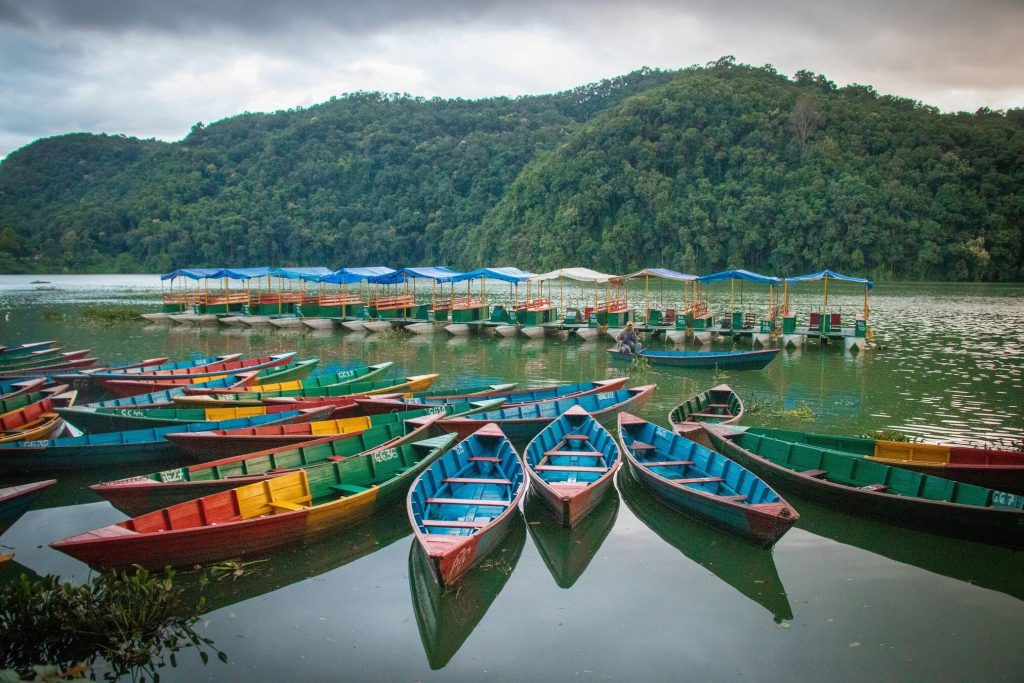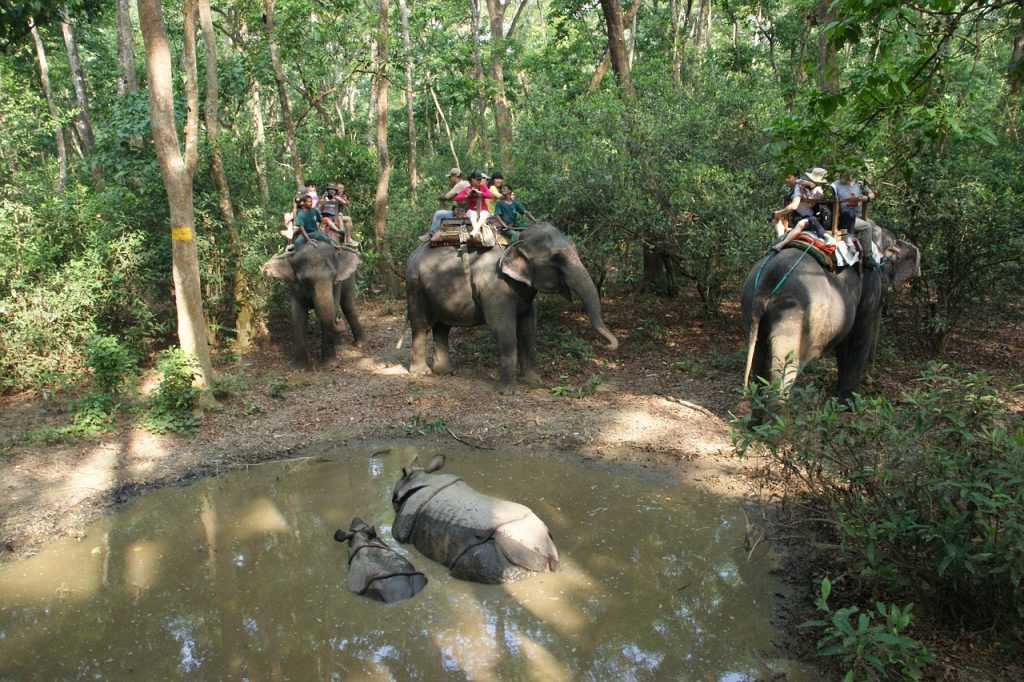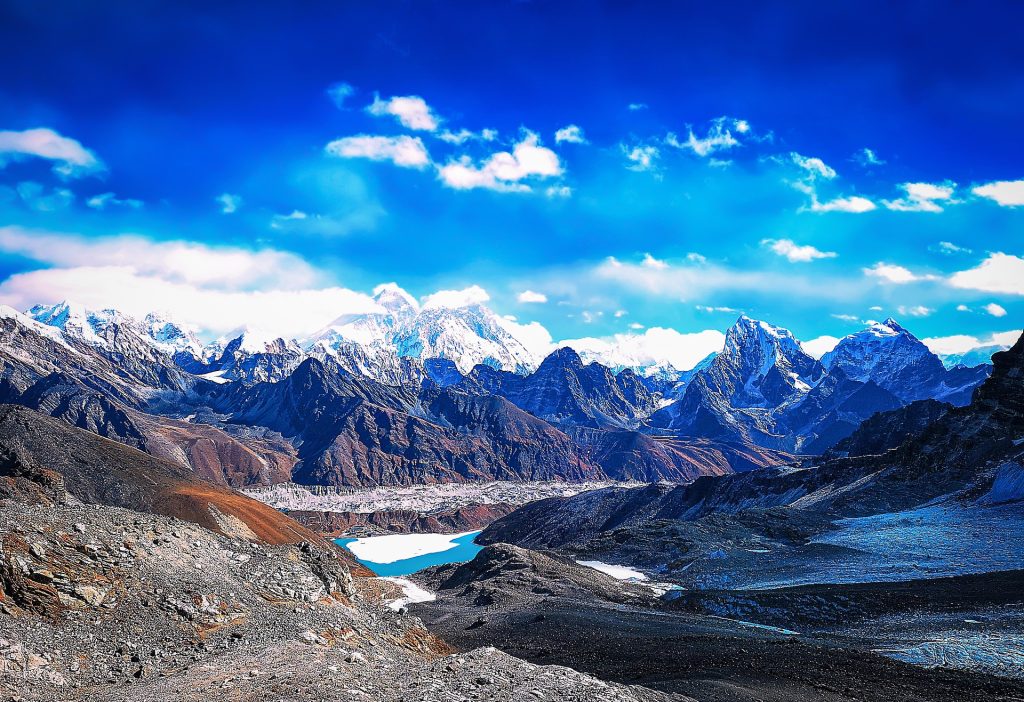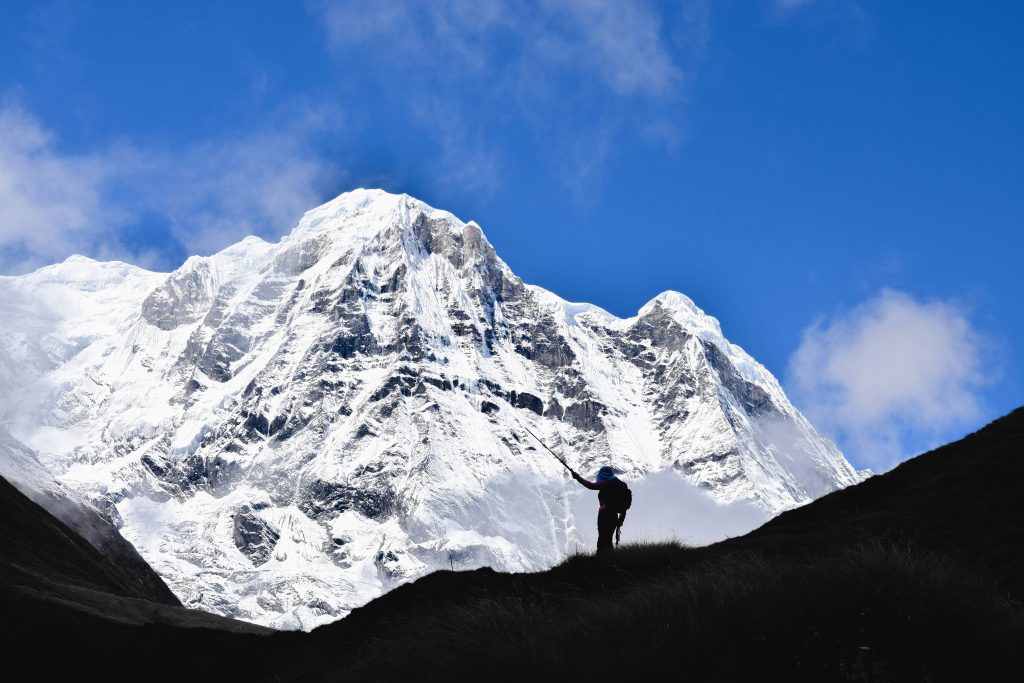About Nepal
Nepal is located in South Asia between China in the north and India in the south, east and west.
Nepal is a landlocked country located in South Asia with China in the north and India in the south, east and west. The country occupies 147,516 sq. km of land and lies between coordinates approximately 28°N and 84°E. Nepal falls in the temperate zone north of the Tropic of Cancer. The entire distance from east to west is about 800 km while from north to south is only 150 to 250 km. Nepal has vast water systems which drain south into India. The country can be divided into three main geographical regions: Himalayan region, mid hill region and the Tarai region. The highest point in the country is Mt. Everest (8,848 m) while the lowest point is in the Tarai plains of Kechana Kalan in Jhapa (60 m).
Whether you seek adventure in the mountains, wildlife experiences in Chitwan, or spiritual journeys through ancient sites, Nepal promises an unforgettable experience for every traveler. Learn More
Climate in Nepal
In northern Nepal summers are cool and winters are severe, while in the south, summers are very hot while winters are mild to cold. Nepal has five seasons: spring, summer, monsoon, autumn and winter.
In the Tarai (southern Nepal), summer temperatures exceed 40° C and above 45 in some areas, while winter temperatures range from 7°C to 23°C. In mountainous regions, hills and valleys, summers are temperate while winter temperatures can plummet to sub zero. The Kathmandu Valley has a pleasant climate with average summer temperatures of 20°C – 35°C and 2°C – 12°C in winter.
Average temperatures in Nepal drop 6°C for every 1,000 m you gain in altitude.
Eighty percent of all the rain in Nepal is received during the monsoon (June-September). Winter rains are more pronounced in the western hills.
There is no seasonal constraint on traveling in and through Nepal. Even in December and January, when winter is at its severest, there are compensating bright sun and brilliant views. As with most of the trekking areas in Nepal, the best time to visit are during spring and autumn. Spring is the time for rhododendrons to bloom while the clearest skies are found after the monsoon in October and November. However, Nepal can be visited the whole year round.
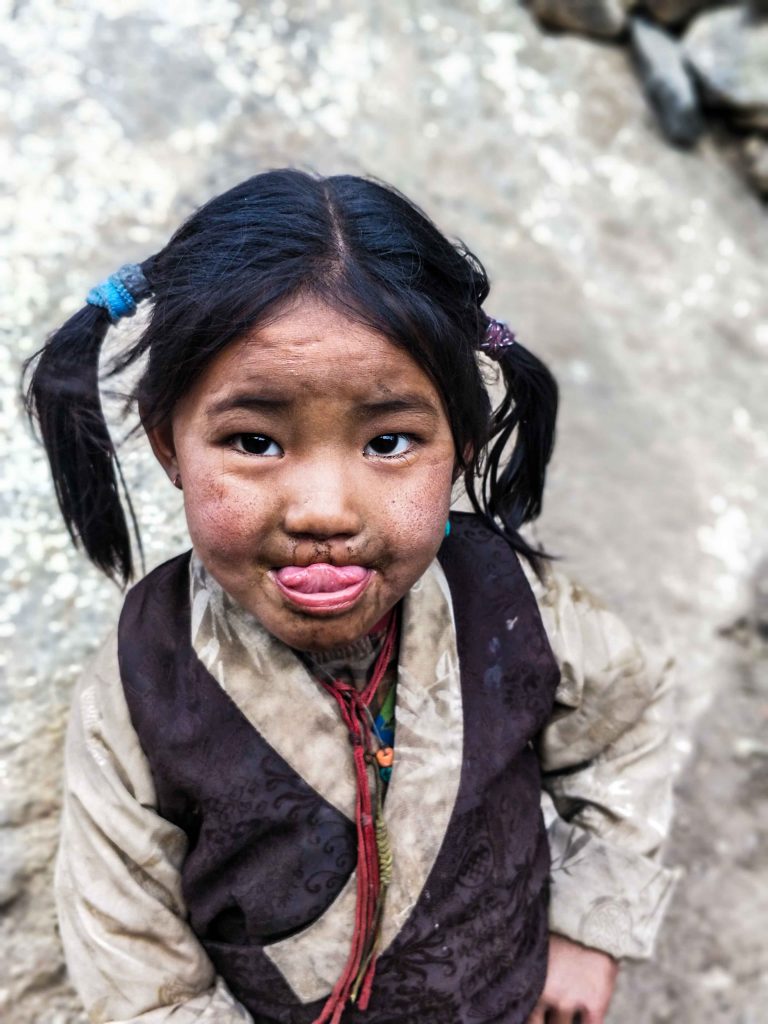
People of Nepal
There are about 101 ethnic groups speaking over 92 languages in Nepal.
The population of Nepal in 2019 is reportedly 29.7 million. There are about 101 ethnic groups speaking over 92 languages. The distinction in caste and ethnicity is understood better with a view of the customary layout of the population. The official language of Nepal is Nepali which is spoken and understood by a majority of the population. The ethnic groups have their own mother tongues. English is taught in schools and many of them are English medium schools so a large portion of the population understands the language. Most private schools today teach in English.
Northern Himalayan People
The mountainous regions of Nepal are inhabited by Sherpas, Dolpa-pas, Lopas, Baragaonlis, Manangays. The Sherpas are mainly found in the east, Solu and Khumbu region; the Baragaonlis and Lopas live in the semi-desert areas of Upper and Lower Mustang in the rain-shadow area; the Manangays live in Manang district while the Dolpa-pas live in Dolpa district of west Nepal.
Continued.............
Middle Hills and Valley People
Several ethnic groups live in the middle hills and valleys. Among them are the Magars, Gurungs, Tamangs, Rais, Limbus, Thamis, Sunuwars, Newars, Thakalis, Chepangs, Brahmins, Chhetris and Thakuris, Damai, Sarki, Kami and Sunar.
Ethnic Diversity in the Kathmandu Valley
Kathmandu Valley represents a cultural melting pot of the country, where people from varied backgrounds have come together to form a diverse population. The natives of the Kathmandu Valley are the Newars. Although Newars are either Hindus or Buddhists, their culture is vastly different from the rest of the Nepali people. Their rituals, food and festivals are unique to them. Newars of Kathmandu Valley were predominantly traders or farmers by occupation.
Terai People
The main ethnic groups in the Terai are Tharus, Darai, Kumhal, Rajbangsi, Bote, Majhi and other groups. They speak north Indian dialects like Maithili and Bhojpuri. Owing to the fertile plains of the Terai, most inhabitants subsist on agriculture. There are, however, some occupational castes like Majhi (fisherman), Kumhal (potter) and Danuwar (cart driver).
CULTURE OF NEPAL
Customs and traditions differ from one part of Nepal to another.
Customs and traditions differ from one part of Nepal to another. The capital city Kathmandu enjoys a rich tapestry of cultures blending to form a national identity. Kathmandu Valley has served as the country’s cultural metropolis since the unification of Nepal in the 18th Century. A prominent factor in a Nepali’s everyday life is religion. Adding colour to the lives of Nepalese are festivals the year round which they celebrate with much pomp and ceremony. Food plays an important role in the celebration of these festivals.
Religion
Nepal was declared a secular country by the Parliament on 18th May 2006. Religions practiced in Nepal are Hinduism, Buddhism, Islam, Christianity, Jainism, Sikhism, Bon, ancestor worship and animism. The majority of Nepalese are either Hindus or Buddhists and these two religions have co-existed in harmony through centuries.
Buddha is widely worshipped by both Buddhists and Hindus of Nepal. The five Dhyani Buddhas; Vairochana, Akshobhaya, Rathasambhava, Amitabha and Amoghasiddhi represent the five basic elements: earth, fire, water, air and ether.
Nepali Hindus worship the ancient Vedic gods. Bramha the Creator, Vishnu the Preserver and Shiva the Destroyer as the Supreme Hindu Trinity. People pray to the Shiva Linga or the phallic symbol of Lord Shiva in most Shiva temples. Shakti, the dynamic element in the female counterpart of Shiva, is highly revered and feared and some of the names given to her are Mahadevi, Mahakali, Bhagabati and Ishwari. Kumari, the Virgin Goddess, also represents Shakti. Other popular deities are Ganesh for luck, Saraswati for knowledge, Lakshmi for wealth and Hanuman for protection. Krishna believed to be the human incarnation of Lord Vishnu is also worshipped widely. Hindu holy scriptures: Bhagawat Gita, Ramayan and Mahabharat are widely read in Nepal. Vedas, Upanishads and other holy scriptures are read by learned Brahmin Pundits during special occasions.
Customs
The diversity in Nepal in terms of ethnicity again makes room for various sets of customs. Most of these customs go back to the Hindu, Buddhist or other religious traditions. Among them, the rules of marriage are particularly interesting. Traditional marriages call for deals arranged by parents after the boy or girl come of age.
The slaughter of cows is illegal in Nepal. The cow is considered a Universal Mother, symbolizing motherhood, charity, and pity. To respect it is to put into practice the concept of Ahimsa, which in Sanskrit literally means "non-violence", an important component of Hinduism, Buddhism and Jainism. Before entering a temple or a house, you will often be asked to take off your shoes, so as not to pollute the pure interiors with your stained soles. Some temples are forbidden to non-Hindus. The right hand, considered pure, is used to eat, pay, give and receive. If rural Nepal is mostly agrarian, some aspects of urban life carry the glitz and glamour of the ultra-modern world.
Food
Food habits differ from region to region and much of Nepali food has been influenced by Indian and Tibetan styles of cooking. However, the Newar people have their unique cuisine which is vast and nutritious. The Thakalis also have a distinct cuisine although the staples are the same daal and bhat which most Nepali people eat. The regular Nepali meal is daal (lentil soup), bhat (boiled rice) and tarkari (curried vegetables), often accompanied by achar (pickle). Curried meat is very popular, but for many, it is saved for special occasions. Momos (steamed or fried dumplings) deserve a mention as one of the most popular snacks among Nepalis. Rotis (flatbread) and dhedo (boiled flour) are also the staple diet in some homes.
PLACES TO VISIT
Kathmandu (The cultural heart of Nepal)
Kathmandu, the capital of Nepal, is a vibrant city where ancient traditions meet modern living. Famous for its rich history, UNESCO World Heritage sites, and lively markets, the city offers a unique blend of Hindu and Buddhist cultures. Explore the iconic Durbar Square, the sacred Swayambhunath (Monkey Temple), and the majestic Boudhanath Stupa. Kathmandu’s bustling streets, charming alleyways, and serene temples make it a must-visit destination for travelers seeking both cultural immersion and spiritual discovery.
Pokhara (The Gateway to Adventure and Serenity)
Nestled beside the tranquil Phewa Lake and surrounded by the stunning Annapurna mountain range, Pokhara is a paradise for nature lovers and adventure seekers. Known for its serene beauty, Pokhara offers breathtaking views of snow-capped peaks, lush green hills, and mirror-like lakes. It’s the starting point for many famous treks, including the Annapurna Circuit and the Poon Hill trek. Visitors can also enjoy activities like boating, paragliding, and exploring caves and waterfalls. Whether you’re looking for adventure or peace, Pokhara offers the perfect blend of both.
Lumbini (The Birthplace of Buddha)
Lumbini, a UNESCO World Heritage site, is a sacred pilgrimage destination and the birthplace of Lord Buddha. Located in the Terai plains of Nepal, this peaceful sanctuary attracts spiritual seekers from around the world. The highlight of Lumbini is the Maya Devi Temple, marking the exact spot of Buddha’s birth. The surrounding monastic zones are home to beautiful monasteries built by various countries, each offering a unique reflection of Buddhist culture. Lumbini’s serene atmosphere, sacred gardens, and rich spiritual heritage make it a must-visit destination for those on a quest for inner peace and enlightenment.
Chitwan (Nepal’s Wildlife Wonderland)
Chitwan, home to the famous Chitwan National Park, offers an unforgettable wildlife experience. As a UNESCO World Heritage site, Chitwan is rich in biodiversity, with dense jungles, grasslands, and rivers teeming with wildlife. Visitors can embark on jungle safaris to spot rare animals like the one-horned rhinoceros, Bengal tigers, elephants, and countless bird species. Beyond the wildlife, Chitwan offers cultural experiences with the indigenous Tharu community, showcasing their unique traditions and way of life. Whether you’re seeking adventure or a glimpse into Nepal’s rich ecological and cultural tapestry, Chitwan is a must-visit destination.
Mount Everest (The Roof of the World)
“Mount Everest, the world’s highest peak at 8,848 meters (29,029 feet), is the crown jewel of the Himalayas and a symbol of ultimate adventure. Located in the Sagarmatha National Park, Everest draws trekkers, mountaineers, and nature lovers from around the globe. The Everest Base Camp trek offers unparalleled views of towering peaks, picturesque Sherpa villages, and ancient monasteries, while providing a unique opportunity to immerse yourself in the culture and traditions of the Sherpa people. Whether conquering its summit or trekking in its shadow, Everest offers a journey of breathtaking landscapes and life-changing experiences.
Annapurna (Trekkers Paradise)
The Annapurna region, home to some of the world’s most iconic trekking routes, offers adventurers a stunning blend of natural beauty and cultural diversity. Dominated by the majestic Annapurna massif, this region provides breathtaking views of snow-capped peaks, lush valleys, and terraced fields. The Annapurna Circuit and Annapurna Base Camp treks are renowned for their diverse landscapes, ranging from subtropical forests to high-altitude deserts. Along the way, trekkers can experience the warm hospitality of the Gurung, Magar, and Thakali communities. Annapurna is not just a trek; it’s a journey through Nepal’s rich natural and cultural heritage.





